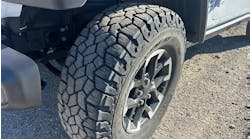Runaway rubber wrecking balls: How proper pre-trips stop wheel-offs
Trucking safety watchdog Rob Carpenter’s LinkedIn feed is littered with dash cam videos that illustrate just how dangerous trucking can be, from pants-soiling near-misses to violent tractor-trailer collisions. So many of these usually avoidable accidents pop up on my social media feeds that I’ve become desensitized. Still, there was one posted in June by Carpenter, VP of managed services at Trucksafe Consulting, that gave me pause.
The dash cam video, which Carpenter found on a Reddit driver forum, was taken from a newer Peterbilt Model 579 driving down a dusty desert highway in the right lane. Another semi passes on the left, clearly going much faster. As the passing tractor-trailer gets about 20 feet ahead, its right rear trailer dual wheel wobbles loose and slides across the Pete’s bow with plenty of room to spare. The dually would have harmlessly rolled through the barren terrain if not for a gentle dune that redirected the runaway tire up in the air like a superball. What goes up must come down, and nine seconds after breaking free of a trailer axle, this wheel forcefully landed on the Pete’s hood on the passenger side.
Watch the video here.
Now look at the damage, which was provided by the body shop estimator, Travis Hetherington, who initially received the damaged truck. The windshield, hood, and side body were destroyed, with damage to the engine as well. The initial estimate was several tens of thousands of dollars, though according to Hetherington, the operator chose to tow the truck to another body shop.
One way to look at this is that it’s a miracle the Peterbilt driver is alive. The dually landing just a foot or two over was the difference between life and death. But that driver’s guardian angel wouldn’t have had to get off his cloud if the other trucker had properly performed the pre-trip inspection on that trailer, and before that, proper maintenance was done on that wheel-end.
Without all the details, it’s really hard to know who in the trailer’s chain of custody was most negligent, but ultimately the driver is responsible. You can imagine all sorts of excuses for why this specific incident happened, but you would need a really vivid imagination to concoct a plausible story for why this continues to be an issue across the industry.
Carpenter said he regularly receives several of these types of videos.
“Incidents like these are becoming more common it seems,” he told Fleet Maintenance. “The frequency reinforces the need for rigorous and regular wheel and tire inspections.
“The fact that these incidents still occur suggests that there is a widespread issue with either the thoroughness of inspections or the consistency of maintenance practices across the industry,” Carpenter continued.
He did note that more people have dash cams, so more wheel-off events are seen now than in the past.
Frequent flying off
“Most fleets are well aware of the potential for wheel-end component failure, though I think videos and statistics do tend to make them more real,” commented Roger Maye, Director of Technical Service at ConMet, a supplier of wheel components and trailer technology.
Without hard data, it’s nigh impossible to know if these accidents are increasing or decreasing. The government does not track them.
But should they start?
“Absolutely, wheel-offs should be tracked by a governmental body,” Carpenter asserted. “Having official data would help quantify the extent of the problem and drive industry-wide improvement.”
Dave Walters, manager of warranty and field service at Alcoa, once called the frequency of wheel-offs “the darkest secret in our industry.”
According to MEA Forensics, upwards of 50,000 wheel-off events occur in North America every year.





